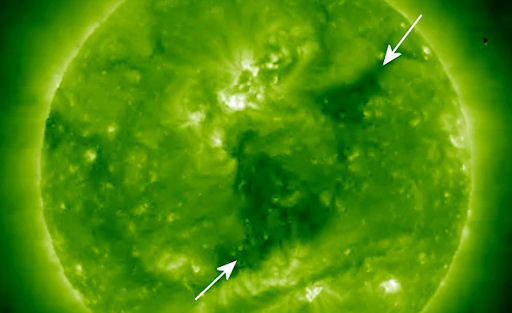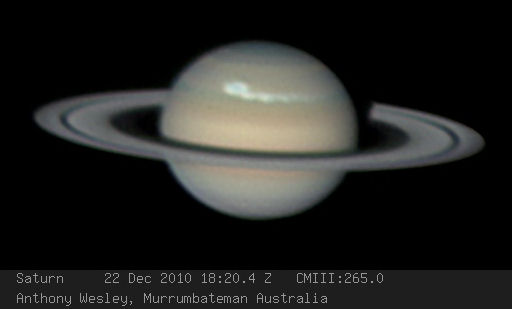Turn your cell phone into a field-tested satellite tracker. Works for Android and iPhone. | | | MORNING SHOW: Set your alarm for dawn. For the next two mornings, Venus and the crescent Moon will be shining together in the southeastern sky before sunrise. It's a good way to begin the day. Sky maps: Dec. 30, 31. CORONAL HOLE: NASA's STEREO-B spacecraft is monitoring a vast hole in the sun's atmosphere--a "coronal hole." It's the dark region denoted by arrows in this extreme ultraviolet image taken during the early hours of Dec. 30th: 
Coronal holes are places in the sun's atmosphere where the solar magnetic field opens up and allows solar wind to escape. A stream of solar wind flowing from this coronal hole should reach Earth on Jan. 2nd or 3rd--the first solar wind stream of the New Year! High-latitude sky watchers should be alert for auroras. 3D SUN: You can see this coronal hole in three dimensions on your iPhone or iPad. Download NASA's 3D Sun app for realtime images from STEREO and free solar activity alerts. GIANT STORM ON SATURN: Got a telescope for Christmas? Point it at Saturn. A giant storm even brighter than Saturn's rings is raging through the planet's cloudtops. "I've never seen anything like this," says veteran planetary photographer Anthony Wesley. "It's possible that this is the biggest storm on Saturn in many decades." Here it is recorded by Wesley's 16-inch telescope on Dec. 22nd: 
Instruments on NASA's Cassini spacecraft are picking up strong bursts of radio static. Apparently, lightning is being generated in multiple cells across the storm front. Cassini's cameras are also beaming back fantastic images of the tempest. "At it's current size and brightness, the storm should be visible to anyone with a mid-size scope under steady seeing," continues Wesley. "This is a great time to be a planetary photographer." [Sky maps: Dec. 29, 30, 31] more images: from Fredy Willems of Waipahu, Hawaii; from Glenn Jolly of Gilbert, Arizona; from Christopher Go of Cebu City, Philippines; from Sadegh Ghomizadeh of Tehran, Iran; from Vincent Lao of Pasig City, Philippines
Lunar Eclipse Photo Gallery
[NASA: "Solstice Lunar Eclipse"] [astronomy alerts]
November 2010 Aurora Gallery
[previous Novembers: 2009, 2008, 2007, 2006, 2004, 2003, 2002, 2001, 2000] Potentially Hazardous Asteroids ( PHAs) are space rocks larger than approximately 100m that can come closer to Earth than 0.05 AU. None of the known PHAs is on a collision course with our planet, although astronomers are finding new ones all the time. On December 30, 2010 there were 1167 potentially hazardous asteroids. Notes: LD means "Lunar Distance." 1 LD = 384,401 km, the distance between Earth and the Moon. 1 LD also equals 0.00256 AU. MAG is the visual magnitude of the asteroid on the date of closest approach. | | The official U.S. government space weather bureau | | | The first place to look for information about sundogs, pillars, rainbows and related phenomena. | | | Researchers call it a "Hubble for the sun." SDO is the most advanced solar observatory ever. | | | 3D views of the sun from NASA's Solar and Terrestrial Relations Observatory | | | Realtime and archival images of the Sun from SOHO. | | | from the NOAA Space Environment Center | | | the underlying science of space weather | | 
